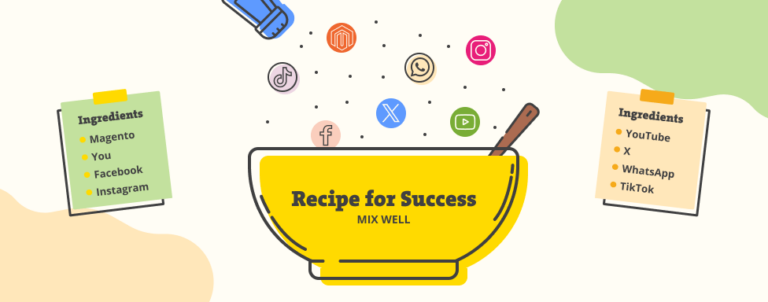When designing an eCommerce site, numerous factors should be taken into account. However, the utmost importance lies in designing with the customer as the primary focus. This perspective serves as the foundation for our design service process. Different shopper types have different goals and shopping strategies, and being aware of these helps us make decisions that improve store usability. While analysing some of our recent projects, and taking into account a number of articles around this topic, we decided to break down online customers into five main types.
The Bargain Hunter
 What motivates the bargain hunter?
What motivates the bargain hunter?
- Coupons
- Promotions
- Discount codes
- Sales
- Free Shipping
Brand loyalty: Low Purchase probability: Medium Description: The Bargain Hunter will spend a lot of time to find the best deal. Usually they will start their search on some of the comparison shopping sites. They are less loyal to a brand and are just looking for the lowest price. Those with stronger brand loyalty will connect with your store via social media waiting for a coupon codes and sales. They often buy products on sale which they don‘t really require, as a excuse they would say that they are actually saving money in the long run by getting everything they need during the sale. UI/UX guidelines for Bargain Hunters:
- Products on sale must be clearly indicated – bargain hunters want to locate special deals as soon as they land on a page. Use labels, icons and other visual elements to make these items stand out. If possible, create On Sale category so they can see all sale-priced items listed on one page.
- List prices, discounts and savings – Cross out retail price and show discounted one, including amount saved.
- Make newsletter forms easy to find and appear in multiple places on your site – give them a clear value proposition for why they should join your email list (exclusive discounts).
- Easy coupon redemption – prominently display a coupon field on the cart or checkout page. Don’t forget to explain how to get codes (modal or tooltip) to avoid the risk of losing customers who don‘t have a code and will leave the site in search of a discount.
- Define a discount based on a specific criteria – e.g. free shipping for customers who spend at least $90.
Power Shopper (product focused)
 What motivates the power shopper?
What motivates the power shopper?
- specific need (a replacement for something they have or something completely new)
- necessity
Brand loyalty: Low / Medium Purchase probability: Medium Description: Power shopper has a specific product on mind and they want to find their desired product in as few steps as possible. If they don’t find it, they will leave right away. UI/UX guidelines for Power Shoppers:
- Place your search bar in a prominent place and keep it consistently placed throughout the rest of the site – Power shoppers will probably use search option to find a product so be sure to make it easily visible. If possible use search bar with auto-complete option and display results with prominent sort and filter options.
- Clear navigation – keep your main navigation well-structured and simple. With well-planned content and a natural organization structure Power shoppers will find their desired products in a few clicks.
- Use clear product descriptions, recognizable names and large images so they can confirm it’s the right product – They don’t want to waste time looking around, they will take a look and if it match their criteria they’ll buy it.
- Provide a convenient and quick checkout – power shoppers values their time so if they found what they were looking for, they want to checkout as quickly as possible.
The Researcher
 What motivates the researcher?
What motivates the researcher?
- specific goal but not a specific product or brand
- to gather as much information as possible
Brand loyalty: Low / Medium Purchase probability: Medium Description: The researcher is browsing with the intention of collecting enough information about products and prices. Search can last for a few days or a few months. They will probably visit multiple sites, so provide them information they need to keep them on your site. UI/UX guidelines for Researches:
- detailed product description – if you provide them with enough helpful data you will become their source of information and therefore turn them into buyers on your site. If they are left with unanswered questions, they will try to find the answers on other sites.
- provide related or similar products links- researchers don’t have a specific product or brand on mind so show them all options you have available.
- ratings and reviews – they rely on ratings and reviews when deciding on a product, so motivate your customers to write reviews and make them prominent on a product page.
- if you have many similar products provide easy product comparison – buying is preceded by a decision and the researcher is undecided, he is comparing the products until he makes a final decision so make it easier for him to make a final decision by comparing products.
- use a persistent shopping cart – more than 20% of shoppers confess using the shopping cart as a wish list to save products for future consideration. Allow them to think about a purchase for a few days and save the information for their next visit.
The Wandering Shopper
 What motivates the wandering shopper?
What motivates the wandering shopper?
- no specific need or desire
Brand loyalty: Low/Medium Purchase probability: Low Description: Wandering shoppers don’t have a specific product or goal in mind, so it is a challenge to convert them into buyers. They study products with no intention of purchasing anything. Usually, this is the largest segment in terms of traffic, but they make up the smallest percentage of revenue. Anyhow, this is not a reason to ignore them, but we should minimize the efforts to attract these shoppers. UI/UX guidelines for Wandering Shoppers:
- Make your site more visually appealing – they have time to socialize, and if they are passionate about your site or specific products, they will very likely communicate to others on social networks and blogs. They are often the source of good marketing.
- Keep them engaged – wandering shoppers in a retail store would pace up and down every aisle. They act similarly in online store, if they like your site they will study the items, rate them, write reviews etc. Clear navigation, cross-sell, up-sell and vivid images will keep them engaged.
The Loyal Shopper
 What motivates the loyal shopper?
What motivates the loyal shopper?
- good experiences with the store
- quality
Brand loyalty: High Purchase probability: Medium/High Description: This segment usually makes up more than 50% of sales. Price is secondary for loyal shoppers, they value quality over price. UI/UX guidelines for Loyal Shoppers:
- Encourage them to repeat orders – Allow them to save shopping carts and create lists of frequent purchases.
- Reward loyalty – customers like feeling appreciated, so thank them for being loyal and encourage them to keep coming back. Whether it’s a discount or reward points, they will appreciate the effort.
How to please everyone?
When you know all types of shoppers, their shopping strategies, and their needs, you should put yourself in their position and see if you have all key approaches to satisfy their varied needs. Share of shopper types can vary greatly from one store to another, but almost every store has these main 5 types of customers. Knowing their behavior patterns will help us identify their problems, and two main factors for a successful store are understanding who your customers are and solving their problems before they arise. If you feel your customers, no matter their type, could have a better experience while shopping on your store, get in touch. Our usability audit can give you detailed explanations of what to improve!



